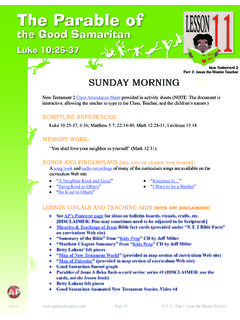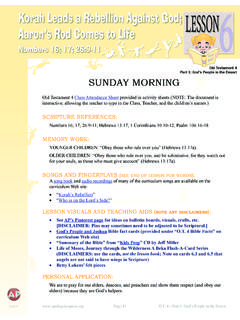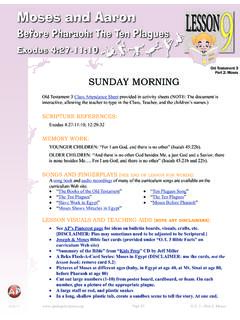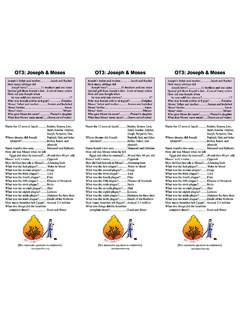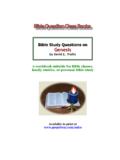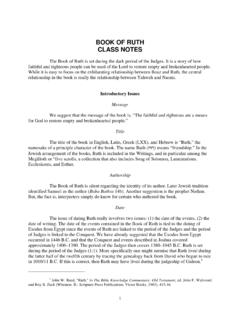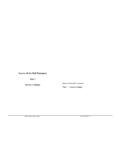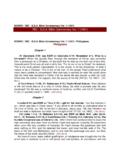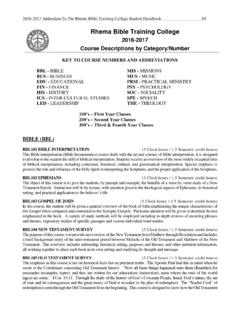Transcription of Exodus 1:1-2:10 - A.P. Curriculum
1 LESSON7 Old Testament 3 Part 2: MosesExodus 1:1-2:10 The Birth of Moses Page 3 Part 2: MosesSUNDAY MORNINGOld Testament 3 class Attendance Sheet provided in activity sheets (NOTE: The document is interactive, allowing the teacher to type in the class , Teacher, and the children s names.)SCRIPTURE REFERENCES: Exodus 1:1-2:10 ; Acts 7:17-22 MEMORY WORK: YOUNGER CHILDREN: And whatever you do in word or deed, do all in the name of the Lord (Colossians 3:17a).OLDER CHILDREN: And whatever you do in word or deed, do all in the name of the Lord Jesus, giving thanks to God the Father through Him (Colossians 3:17).
2 SONGS AND FINGERPLAYS (see end of lesson for words):A song book and audio recordings of many of the Curriculum songs are available on the Curriculum Web VISUALS AND TEACHING AIDS (note any disclaimers): See AP s Pinterest page for ideas on bulletin boards, visuals, crafts, etc. [DISCLAIMER: Pins may sometimes need to be adjusted to be Scriptural.] Joseph & Moses Bible fact cards (provided under 3 Bible Facts on Curriculum Web site) Summary of the Bible from Kids Prep CD by Jeff Miller Betty Lukens felt pieces Map or globe of ancient world A Beka Flash-A-Card Series: Moses in Egypt (DISCLAIMER: use the cards, not the lesson book; remove card ) Pictures of the Nile RiverPERSONAL APPLICATION: I can help others (take responsibility), like Miriam did, no matter how young I The Books of the Old Testament Little Baby Moses Baby Moses Baby Moses LESSON STARTS HEREThe Birth of Moses Page 48 INTRODUCTION: (YOUNGER CHILDREN)A long time ago in a place called Egypt, a little boy was born.
3 The baby had a very special mother, father, brother, and sister. They took care of him and protected him. His name was : (OLDER CHILDREN)When Joseph was a powerful man in Egypt, his father, brothers, and their families moved to Egypt, to an area called Goshen. For many years the Israelites lived in Goshen as free people, and their numbers grew. (Explain to the children that Israelites, Hebrews, and Jews are all titles referring to the same people, , the descendants of Abraham, Isaac, and Jacob.)After many years, there arose a new king over Egypt, who did not know Joseph and was not interested in helping the Hebrews (Israelites). There were so many Hebrews that the Egyptian king (called Pharaoh ) was afraid they might decide to take over his country.
4 ( Exodus 12:37 records that there were 600,000 Hebrew men not counting women and children!) Pharaoh decided that all the Hebrews should be his slaves. So he appointed taskmasters to make the Israelites work, building entire cities from bricks that they had made Egyptians thought if they were mean to the Hebrew people and made them work very hard, they would not have as many children, and many of them would eventually die. But there were still many Hebrew babies born. So, Pharaoh gave orders to the midwives that they were to kill every baby boy that was born. The midwives did not follow the king s orders. Two midwives who are named specifically (Shiphrah and Puah), believed in God and knew that to kill innocent babies is Pharaoh found out that the midwives weren t obeying his orders, he told the Egyptian people to take all Hebrew baby boys when they were born and throw them into the Nile NOTES: Though the exact location of Goshen is not known, it is thought to have been slightly northeastward of the present-day Gulf of Suez.
5 This area was then, and is now, a part of the very fertile Nile probably died around 1640 NOTE: The ancient Jewish historian Josephus wrote that Egyptian prophets ( seers ) predicted the birth of a Hebrew child who would crush the power of : women who help deliver 3 Part 1: Joseph Page 49 POINTS TO EMPHASIZE:1. The king of Egypt was trying to get rid of all the baby boys of the Hebrew slaves. There was a Hebrew couple named Jochebed and Amram who wanted very much to protect their baby boy. They already had a daughter, Miriam (about 14 years old), and a son, Aaron (three years old). The youngest son was very special to them, too. For three months they managed to hide the baby boy from the Egyptians, but after that time, Jochebed and Amram knew they would have to do something They used reeds (tall plants that grow near water) to make a basket (or small boat/ ark ) with a lid and covered it with tar to help the basket float and to keep their baby dry.
6 (Remember that when Noah built the ark, he covered it with tar and pitch to make it waterproof.) They put their baby son in the little boat and hid it in the Nile River among the tall reeds. Because there were probably crocodiles and hippos in the river, Miriam hid in a place where she could watch the basket to make sure nothing happened to her little brother. 3. We don t know how many days the family hid the baby in the little boat, but we do know that one day an Egyptian woman found him when she came down to the river to take a bath. The woman was the daughter of the Pharaoh: a princess. When the princess saw the little boat, she sent one of her servants to get it.
7 When she took the lid off and saw the baby, she realized that it was a Hebrew baby. He was crying, and she felt sorry for him. She decided to keep the baby boy for herself and raise him in the palace. 4. Of course, Miriam was not far away and saw what had happened. She came to the princess and said she knew of a woman who could care for the baby, and the princess gave Miriam permission to bring that woman to her. Miriam went and got the baby s own mother, Jochebed. The princess said she would pay Jochebed for taking care of the baby. So Jochebed took the baby back home to take care of him, without having to be afraid any more that he would be After some time, Jochebed took the boy to Pharaoh s daughter in the palace.
8 From that time on, the princess took care of the boy as if he were her very own son. She named him Moses (which most scholars believe means drawn out [of water] ).6. It was Miriam s responsibility (her job) to take care of her baby brother. It was not an easy job, but she knew it was important, and she did her best. We all have jobs or chores we are asked to do; we must do everything we are asked to do as well as we possibly can. [Discuss each child s responsibilities at home.]HISTORICAL NOTE: Remind the older children that Egypt is on the continent of Africa, and the Nile River flows from the Equator northward to the Mediterranean Sea.
9 At this time in history, Egypt was one of the most important and powerful countries in the world. For hundreds of years, the empire had the most powerful army in the world, as well as being the center of education, art, agriculture, and medicine. Moses probably visited the pyramids near the city of Memphis, which had been built 1200-1500 years before his Birth of Moses Page 50 Pre-C lAss ACTIVITIes/leArnInG CenTers (To be used As ChIldren Are ArrIVInG before class , And uP To The fIrsT fIV e mInuTes of class ; or As homework): Click here for complete Activity Book and Answer 2-5: The Birth of Moses Coloring Sheet (provided in activity sheets) Prepare a river scene on the table, using construction paper, tissue paper, Play-doh/modeling clay, and/or blocks; or prepare the scene on an 11x15 jelly-roll pan with real water running between banks of Play-doh/modeling clay.
10 Provide a small basket and appropriately sized baby doll for each child. With very young children, talk about what babies need and how their families take care of them. Give four and five year olds small amounts of black, brown, or dark blue Play-doh to cover the inside of their baskets and make them waterproof. 1st-2nd Graders: Write key words from the story on cards and put them on the walls, scattered around the room. Show the children pictures that match the words, one at a time. As you show them a picture, ask them to find a word on a wall that best describes it. The Birth of Moses Word Search (provided in activity sheets) Have the children read: Baby Moses, James Leininger, The Beginners Bible Just Me in the Tub, by Gena and Mercer Mayer Baby Moses in a Basket, by Patricia Mahany, Happy Day Books3rd-4th Graders: The Birth of Moses Word Search (provided in activity sheets) The Birth of Moses Fill in the Blank activity (provided in activity sheets) Have the children read the following: Exodus chapters 1-2 Safe in a Basket, by Patricia Nederveld, CRC Publications Moses, A Bible Pop-Up Storybook, Grandreams The Story of Moses, by Maissa Bessada, Creative 3 Part 1: Joseph Page 51 FINGERPLAYS.
